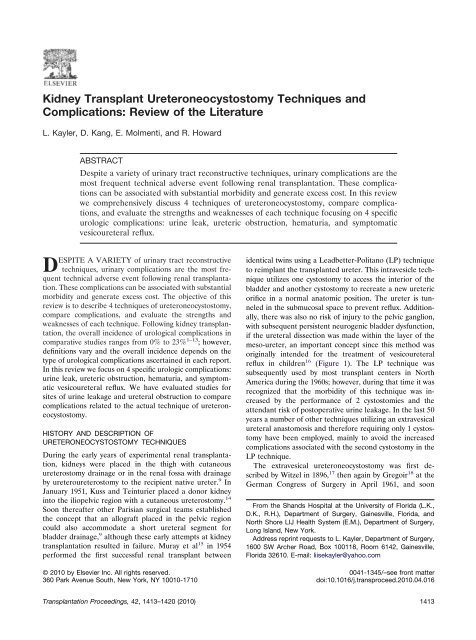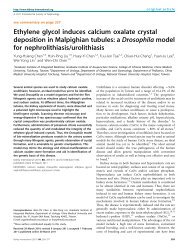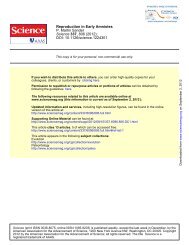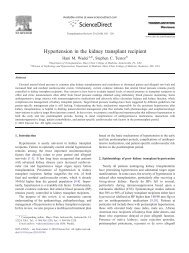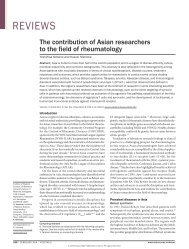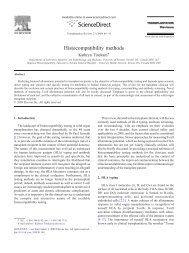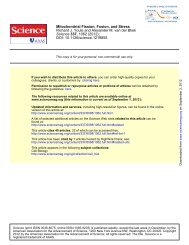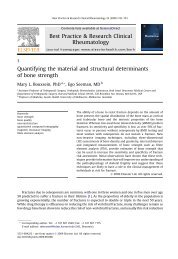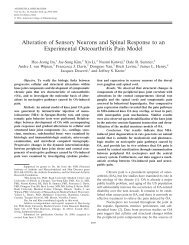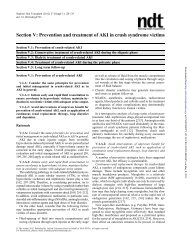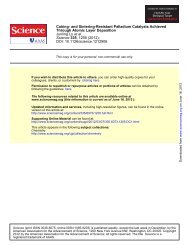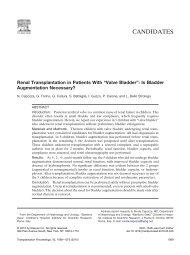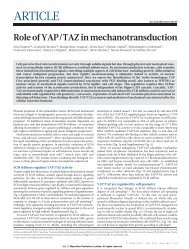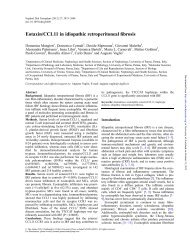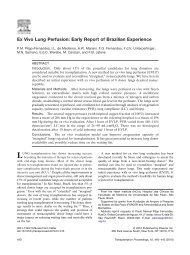Kidney Transplant Ureteroneocystostomy Techniques and ...
Kidney Transplant Ureteroneocystostomy Techniques and ...
Kidney Transplant Ureteroneocystostomy Techniques and ...
You also want an ePaper? Increase the reach of your titles
YUMPU automatically turns print PDFs into web optimized ePapers that Google loves.
<strong>Kidney</strong> <strong>Transplant</strong> <strong>Ureteroneocystostomy</strong> <strong>Techniques</strong> <strong>and</strong><br />
Complications: Review of the Literature<br />
L. Kayler, D. Kang, E. Molmenti, <strong>and</strong> R. Howard<br />
ABSTRACT<br />
Despite a variety of urinary tract reconstructive techniques, urinary complications are the<br />
most frequent technical adverse event following renal transplantation. These complications<br />
can be associated with substantial morbidity <strong>and</strong> generate excess cost. In this review<br />
we comprehensively discuss 4 techniques of ureteroneocystostomy, compare complications,<br />
<strong>and</strong> evaluate the strengths <strong>and</strong> weaknesses of each technique focusing on 4 specific<br />
urologic complications: urine leak, ureteric obstruction, hematuria, <strong>and</strong> symptomatic<br />
vesicoureteral reflux.<br />
DESPITE A VARIETY of urinary tract reconstructive<br />
techniques, urinary complications are the most frequent<br />
technical adverse event following renal transplantation.<br />
These complications can be associated with substantial<br />
morbidity <strong>and</strong> generate excess cost. The objective of this<br />
review is to describe 4 techniques of ureteroneocystostomy,<br />
compare complications, <strong>and</strong> evaluate the strengths <strong>and</strong><br />
weaknesses of each technique. Following kidney transplantation,<br />
the overall incidence of urological complications in<br />
comparative studies ranges from 0% to 23% 1–13 ; however,<br />
definitions vary <strong>and</strong> the overall incidence depends on the<br />
type of urological complications ascertained in each report.<br />
In this review we focus on 4 specific urologic complications:<br />
urine leak, ureteric obstruction, hematuria, <strong>and</strong> symptomatic<br />
vesicoureteral reflux. We have evaluated studies for<br />
sites of urine leakage <strong>and</strong> ureteral obstruction to compare<br />
complications related to the actual technique of ureteroneocystostomy.<br />
HISTORY AND DESCRIPTION OF<br />
URETERONEOCYSTOSTOMY TECHNIQUES<br />
During the early years of experimental renal transplantation,<br />
kidneys were placed in the thigh with cutaneous<br />
ureterostomy drainage or in the renal fossa with drainage<br />
by ureteroureterostomy to the recipient native ureter. 9 In<br />
January 1951, Kuss <strong>and</strong> Teinturier placed a donor kidney<br />
into the iliopelvic region with a cutaneous ureterostomy. 14<br />
Soon thereafter other Parisian surgical teams established<br />
the concept that an allograft placed in the pelvic region<br />
could also accommodate a short ureteral segment for<br />
bladder drainage, 9 although these early attempts at kidney<br />
transplantation resulted in failure. Muray et al 15 in 1954<br />
performed the first successful renal transplant between<br />
identical twins using a Leadbetter-Politano (LP) technique<br />
to reimplant the transplanted ureter. This intravesicle technique<br />
utilizes one cystostomy to access the interior of the<br />
bladder <strong>and</strong> another cystostomy to recreate a new ureteric<br />
orifice in a normal anatomic position. The ureter is tunneled<br />
in the submucosal space to prevent reflux. Additionally,<br />
there was also no risk of injury to the pelvic ganglion,<br />
with subsequent persistent neurogenic bladder dysfunction,<br />
if the ureteral dissection was made within the layer of the<br />
meso-ureter, an important concept since this method was<br />
originally intended for the treatment of vesicoureteral<br />
reflux in children 16 (Figure 1). The LP technique was<br />
subsequently used by most transplant centers in North<br />
America during the 1960s; however, during that time it was<br />
recognized that the morbidity of this technique was increased<br />
by the performance of 2 cystostomies <strong>and</strong> the<br />
attendant risk of postoperative urine leakage. In the last 50<br />
years a number of other techniques utilizing an extravesical<br />
ureteral anastomosis <strong>and</strong> therefore requiring only 1 cystostomy<br />
have been employed, mainly to avoid the increased<br />
complications associated with the second cystostomy in the<br />
LP technique.<br />
The extravesical ureteroneocystostomy was first described<br />
by Witzel in 1896, 17 then again by Gregoir 18 at the<br />
German Congress of Surgery in April 1961, <strong>and</strong> soon<br />
From the Sh<strong>and</strong>s Hospital at the University of Florida (L.K.,<br />
D.K., R.H.), Department of Surgery, Gainesville, Florida, <strong>and</strong><br />
North Shore LIJ Health System (E.M.), Department of Surgery,<br />
Long Isl<strong>and</strong>, New York.<br />
Address reprint requests to L. Kayler, Department of Surgery,<br />
1600 SW Archer Road, Box 100118, Room 6142, Gainesville,<br />
Florida 32610. E-mail: liisekayler@yahoo.com<br />
© 2010 by Elsevier Inc. All rights reserved. 0041-1345/–see front matter<br />
360 Park Avenue South, New York, NY 10010-1710 doi:10.1016/j.transproceed.2010.04.016<br />
<strong>Transplant</strong>ation Proceedings, 42, 1413–1420 (2010) 1413
1414 KAYLER, KANG, MOLMENTI ET AL<br />
Fig 1. Politano-Leadbetter intravesical technique. 13 An anterior<br />
cystostomy is performed to visualize the interior of the bladder.<br />
A retractor is used to flatten the trigone, <strong>and</strong> a circumferential<br />
incision is made around the ureteral orifice. A neohiatus is made,<br />
into which the transplanted ureter is inserted <strong>and</strong> a submucosal<br />
tunnel created. The distal ureter is sutured in place with absorbable<br />
sutures, <strong>and</strong> the bladder is closed in 2 layers.<br />
thereafter by Lich et al, 19 who published the technique in<br />
November 1961. The Lich-Gregoir (LG) technique was<br />
designed to avoid a second cystostomy, yet retain an<br />
antireflux mechanism. It consisted of anastomosis of the<br />
distal ureter to the bladder mucosa, which was then buried<br />
in a muscular tunnel intended to provide a valve effect<br />
(Figure 2). In addition to the avoidance of a separate<br />
cystostomy, other comparative advantages were less bladder<br />
dissection, a shorter ureteral length, <strong>and</strong> no interference<br />
with native ureteral function. Additionally, the LG was<br />
noted to be rapid <strong>and</strong> technically easier to perform than the<br />
LP technique. 9 Several variations of the LG implantation<br />
have been described, such as the use of running instead of<br />
interrupted sutures to create the ureteral mucosal anastomosis,<br />
9,13,20,21 performance of a tunnel by submucosal blunt<br />
dissection instead of muscular imbrication, 22 placement of a<br />
single horizontal Halsted stitch at the proximal apex of the<br />
bladder incision to the ureter to prevent tension at the acute<br />
angle of the anastomosis, 21 placement of an anchor stitch<br />
on the distal ureteral tip to the full thickness of the<br />
bladder, 23 folding back the tip of the ureter to make a<br />
terminal cuff, 24 <strong>and</strong> incorporation of the muscular layer<br />
with the mucosal layer of the bladder in the anastomosis.<br />
22,25 All of these so-called modified Lich ureteroneocystostomies<br />
include extravesicular access, the formation of an<br />
antireflux tunnel, <strong>and</strong> a urothelial anastomosis.<br />
Another extravesical approach to ureteroneocystostomy<br />
that also includes an antireflux tunnel but lacks a urothelial<br />
anastomosis, herein called the U-stitch technique, was<br />
described separately by Shanfield 26 <strong>and</strong> MacKinnon et al. 27<br />
The spatulated ureter is passed through the bladder opening<br />
<strong>and</strong> the sutures taken out through the anterior bladder<br />
Fig 2. Lich-Gregoir extravesical technique. 16 An incision is<br />
made in the bladder wall musculature at the dome for 2 to 3 cm<br />
to expose mucosa of the bladder wall. A small incision is made<br />
in the mucosa. The mucosa of the bladder is then sutured to the<br />
ureteral end with interrupted absorbable sutures. The detrusor<br />
muscle is then closed over the anastomosis to create a submucosal<br />
tunnel with an antireflux mechanism.
KIDNEY TRANSPLANT LITERATURE REVIEW 1415<br />
wall so that the ureteral end is ancored to the inner bladder<br />
wall (Figure 3). The tunneling procedure is performed in a<br />
similar manner to LG by imbricating the seromuscular layer<br />
Fig 3. U-stitch technique. 23,24 An incision is made in the bladder wall<br />
musculature at the dome for 2 to 3 cm to expose the mucosa of the<br />
bladder wall. An absorbable U-stitch is placed on the anterior aspect<br />
of the ureter so that each thread comes out into the ureteral lumen. An<br />
incision is made in the bladder mucosa. The ureteral end is then<br />
brought through the bladder mucosa after each thread is passed<br />
through <strong>and</strong> taken out through the bladder 2 cm distal to the caudal<br />
edge of the ureteral orifice. The U-stitch is then tied, anchoring the<br />
ureteral end against the inside of the bladder. The detrusor muscle is<br />
then closed over the anastomosis to create a submucosal tunnel with<br />
an antireflux mechanism.<br />
over the ureter. The technique described by Shanfield 26<br />
uses only 1 stitch for the bladder attachment placed at the<br />
distal aspect of the ureter, whereas that described by<br />
MacKinnon et al 27 uses 2 stitches at the distal aspect of the<br />
ureter. By elimination of the urothelial anastomosis, the<br />
U-stitch technique was demonstrated to shorten operative<br />
times even further than that of the LG technique. The average<br />
operative time was reduced from 29 minutes with the LG<br />
procedure to 14.2 minutes with the U-stitch technique (P <br />
.02) in one study (8) <strong>and</strong> from 24.6 minutes to 10.2 minutes,<br />
respectively, in another report. 11<br />
The last type of extravesicle ureteroneocystostomy technique<br />
utilized for kidney transplantation, <strong>and</strong> the least often<br />
described, is one that does not employ an antireflux mechanism<br />
based on the idea that antireflux procedures may be<br />
less important when dealing with normal ureters <strong>and</strong> bladders.<br />
Although several different non-antireflux techniques<br />
have been described, in all reports the spatulated ureter is<br />
brought directly into the bladder without any attempt to<br />
tunnel it. 28–30 Lucas et al 29 <strong>and</strong> Woodruff et al 28 separately<br />
performed this method as an intravesicle technique utilizing<br />
parallel incisions <strong>and</strong> performance of the ureterovesical<br />
anastomosis of the ureter to the muscularis from inside the<br />
bladder. Starzl 30 took a more direct approach through a<br />
single cystostomy suturing the ureteral mucosa to the<br />
bladder mucosa. In this review, we depict a technique used<br />
at our center in which the ureter is directly anastomosed to<br />
the full thickness of the bladder (Figure 4).<br />
COMPLICATIONS<br />
Urine Leak<br />
In comparative analyses, the incidence of urine leak is 0%<br />
to 9.3% of cases (Table 1). In 6 retrospective analyses <strong>and</strong><br />
2 prospective r<strong>and</strong>omized trials, 2,6 there were no significant<br />
differences in the proportion of leaks between the LG <strong>and</strong><br />
LP methods. 1,3–5 One report by Hoogh et al 7 found a<br />
significant difference in the proportion of leaks between the<br />
2 groups with 10/108 leaks in the LP group (9.3%) compared<br />
to 1/133 urine leaks in the LG group (0.8%). Of the<br />
10 leaks on the LP group, 4 were from the cystostomy, <strong>and</strong><br />
it was the separate cystostomy that was credited for the<br />
difference.<br />
In 6 comparative studies, 1 of which was prospective <strong>and</strong><br />
r<strong>and</strong>omized, 11 urine leakage was proportionately similar in<br />
the LG <strong>and</strong> U-stitch groups. 3,8,10–13 One report noted<br />
significantly more leaks in the U-stitch compared to the LG<br />
group (5.7% vs. 2.2%, respectively, P .018). 9 The surgeons<br />
at this single center typically used the LG technique,<br />
but 2 surgeons had switched to the U-stitch technique for<br />
several months during the observation period, thus potentially<br />
introducing a selection bias in terms of surgical<br />
experience. There was also no analysis of early versus late<br />
complications or comments about the learning curve. The<br />
authors stated that 71% of the patients in the U-stitch <strong>and</strong><br />
100% of those in the LG group who had leakage or stricture<br />
were nonstented. They suggested that since the use of stents<br />
was not controlled in their study, they could not determine
1416 KAYLER, KANG, MOLMENTI ET AL<br />
Fig 4. Full-thickness technique. A cystostomy is made through<br />
all layers of the bladder. The spatulated ureter is continuously<br />
sutured to the full thickness of the bladder (mucosa, musculature,<br />
<strong>and</strong> serosa) using absorbable suture. There is no additional<br />
closure of the bladder muscle layer over the anastomosis.<br />
whether the high rate of leakage in the U-stitch group could<br />
have been prevented.<br />
One retrospective study by Lucas et al 28 reported an<br />
absence of leaks in 112 kidney transplant recipients who<br />
underwent a antireflux technique versus 52 recipients transplanted<br />
with a non-antireflux technique (n 52). In both<br />
methods, parallel incisions were made for intravesicular<br />
access to the bladder <strong>and</strong> the urothelial anastomosis incorporated<br />
bladder muscularis. In the antireflux group, the<br />
tunnel was performed in the submucosal layer by blunt<br />
dissection with a tonsil clamp, <strong>and</strong> for the other group there<br />
was no attempt to tunnel the ureter.<br />
Anastomotic urine leaks can be ureteral or vesical in<br />
origin. 13 Extravesical techniques decrease the risk of leaks<br />
by obviating the need for a separate cystostomy. Technical<br />
issues may arise with the LG technique when the bladder<br />
mucosa is extremely thin, allowing for urine filtration<br />
through 1 or more suture orifices or when the thin mucosa<br />
tears away from the suture lines. 13 Urine leakage with the<br />
U-stitch technique has been attributed to the lack of a<br />
mucosal-to-mucosal anastomosis. 11 The incorporation of<br />
muscularis in the anastomosis in both groups in the study by<br />
Lucas et al 28 may have strengthened the anastomosis<br />
against leakage. Nontechnical risk factors for the development<br />
of urine leakage include: recipient age, number of<br />
renal arteries, site of arterial anastomosis, the occurrence of<br />
acute rejection episodes, bladder problems, <strong>and</strong> immunosuppressive<br />
regimen. 31<br />
Ureteral Obstruction<br />
In comparative studies, the incidence of ureteral obstruction<br />
ranges from 1% to 8.3% (Table 1). Four retrospective<br />
1,3,5,7 plus 1 prospective 2 analyses did not demonstrate<br />
any significant difference in the proportion of ureteral<br />
obstructions between the LG <strong>and</strong> LP techniques; however,<br />
2 studies 4,6 reported significant but conflicting findings<br />
comparing LP to LG. In a retrospective analysis, Thrasher<br />
et al 4 observed significantly higher proportions of ureteral<br />
obstruction overall in the LP (5.6%) compared to the LG<br />
(1.3%) group, specifically identifying obstruction at the<br />
ureterovesicle junction (UVJ) to be the main reason for the<br />
difference (1/160 LG vs. 6/160 LP, P .05). In this study, a<br />
single surgeon performed both types of implantation during<br />
2 different eras under identical immunosuppression. The<br />
groups were well matched in terms of recipient age, renal<br />
allograft source, <strong>and</strong> diabetic status, but significantly more<br />
men underwent LP implantation. Gender, however, is not<br />
known to be a risk factor for UVJ obstruction. The authors<br />
believed that the difference in UVJ obstruction related to<br />
technique, citing several disadvantages of the LP technique<br />
including: (1) UVJ obstruction due to kinking of the ureter<br />
within the new muscular hiatus in the bladder, (2) damage<br />
to the adventitial blood supply while h<strong>and</strong>ling the terminal<br />
ureter during placement in the submucosal tunnel with<br />
subsequent ischemia <strong>and</strong> stenosis, <strong>and</strong> (3) increased risk of<br />
the distal ureter to ischemic injury in the LP due to the<br />
greater ureteral length needed to perform the technique.<br />
An advantage of extravesical techniques for prevention of<br />
ureteral stenosis is the ability to use a shorter segment of<br />
the ureter <strong>and</strong> possibly decreased h<strong>and</strong>ling of the ureter. In<br />
contrast, another study by Waltke et al, 6 in which 131<br />
patients were prospectively r<strong>and</strong>omized to 1 of 2 techniques,<br />
reported a 0% anastomotic obstruction rate with LP<br />
implantation performed by 1 of 2 surgeons who utilized<br />
stents in all cases compared to 6.3% with the LG technique<br />
performed by a third surgeon without stent usage (P .05).<br />
The groups were otherwise comparable in terms of age, sex,
KIDNEY TRANSPLANT LITERATURE REVIEW 1417<br />
etiology of end-stage renal disease, <strong>and</strong> immunosuppression.<br />
The authors did not provide a definitive cause of<br />
obstruction <strong>and</strong> hypothesized that it was related to anastomotic<br />
scarring or placement of the ureteroneocystostomy<br />
on the dome of the bladder. 6 They did not discuss the<br />
potential selection bias introduced by various surgeons<br />
performing different techniques or the disparities in stent<br />
usage.<br />
Most comparative analyses have shown no differences in<br />
ureteral obstruction rates between the LG <strong>and</strong> U-stitch<br />
methods. 3,8,10–13 However, in one report the U-stitch group<br />
showed a higher proportion of ureteral obstructions compared<br />
to the LG group (3.1% vs. 0.3%, respectively, P <br />
.003). 9 In this retrospective study, patients were well<br />
matched for demographic factors; however, differences may<br />
have been due to surgeon inexperience since it involved<br />
surgeons who typically performed the LG implantation,<br />
with 2 surgeons performing the U-stitch instead of the LG<br />
technique during 19 of the 27-month study period. Also, a<br />
Table 1. Urologic Complications in Comparative Studies<br />
Ref. Year F/U Type DD (%) Stent (%) Leak (%) Obstruction a (%) Hematuria b (%) Reflux c (%)<br />
1 2009 2 y LG NR 92 8/412 (1.9) 13/412 (3.2) NR NR<br />
LP NR 100 9/265 (3.4) 12/265 (4.5) NR NR<br />
2 1995 d NR LG 50 5/150 (3.3) 5/150 (3.3) 2/150 (1.3) e<br />
LP 50 8/150 (5.3) 8/150 (5.3) 22/150 (14.7)<br />
3 1994 4 m LG NR 0 4/295 (1.4) 3/295 (1.0) 1/295 (0.3)<br />
U NR 0 2/481 (0.004) 22/481 (4.6) 6/481 (1.3)<br />
LP NR 0 7/410 (1.7) 18/410 (4.0) 7/410 (1.7)<br />
4 1990 LG 76 NR 2/160 (1.3) 2/160 (1.3) e NR NR<br />
LP 88 NR 2/160 (1.3) 9/160 (5.6) NR NR<br />
5 1988 NR LG 0 NR 2/125 (1.6) 1/125 (0.8) NR NR<br />
LP 0 NR 5/125 (3.2) 0/125 (0) NR NR<br />
6 1982 d NR LG 100 100 2/72 (2.8) 6/72 (8.3) e NR NR<br />
LP 100 0 2/59 (3.4) 0/59 (0) NR NR<br />
7 1977 5 m LG NR NR 1/133 (0.8) e 5/133 (3.8) NR NR<br />
LP NR NR 10/108 (9.3) 1/108 (0.9) NR NR<br />
8 2007 f LG 73 14 6/238 (2.5) 5/238 (2.1) 3/238 (1.3) e 2/238 (0.8)<br />
U 93 17 6/73 (8.2) 3/73 (4.1) 6/73 (8.2) 1/73 (1.4)<br />
9 2007 3 y LG NR 20 8/360 (2.2) e 1/360 (0.3) e 5/360 (1.4) e<br />
U NR 24 20/353 (5.7) 11/353 (3.1) 21/353 (5.9)<br />
10 2007 NR LG NR NR 6/217 (2.8) 3/217 (1.4) NR NR 0/217 (0)<br />
U NR NR 2/60 (3.3) 1/60 (1.7) NR NR 0/60 (0)<br />
11 2005 d f LG 100 100 1/100 (1.0) 2/100 (2.0) 1/100 (1.0)<br />
U 100 100 0/44 (0.0) 1/44 (2.2) 3/44 (6.8)<br />
12 2003 1 y LG 73 NR 5/148 (3.4) 11/148 (7.4) 5/148 (3.4) e<br />
U 83 NR 0/64 (0) 2/64 (3.1) 22/64 (34.0)<br />
13 2002 f LG 36 0 22/416 (5.3) 23/416 (5.5) 6/416 (1.4) e 8/416 (1.9)<br />
U 72 e 0 11/159 (6.9) 7/159 (4.4) 5/159 (3.1) 0/159 (0)<br />
DD, deceased-donor; F/U, follow-up minimum; NR, not reported; LG, Lich-Gregoir; LP, Leadbetter-Politano; U, U-stitch; Ref, reference.<br />
a<br />
Includes ureteropelvic <strong>and</strong> ureterovesical obstruction. When data were available, we excluded cases of obstruction that were not related to technique, including<br />
stone, lymphocele, spermatic cord compression, hematoma, tumor, etc. Exclusion of cases did not change the significance of any of the findings, but reflects the<br />
incidence of complications that may be more attributable to technique for the purposes of this review.<br />
b<br />
Hematuria was defined as requirement for continuous bladder irrigation <strong>and</strong> bedside clot evacuation, cystoscopy for clot evacuation or fulguration, or reoperation<br />
for bleeding or complications of hematuria for reference 9. For references 11 <strong>and</strong> 3, hematuria was defined as the requirement of cystoscopy or surgery only.<br />
Definitions were not provided in the remaining studies.<br />
c<br />
Symptomatic reflux only. VCUG not routinely performed.<br />
d<br />
Prospective r<strong>and</strong>omized trial.<br />
e<br />
Significant difference between the 2 groups of the same study (P .05).<br />
f<br />
Ref. 8, mean follow-up between the 2 groups was similar, 33.4 months for LG <strong>and</strong> 37 months for U-stitch. Ref. 11, mean follow-up was 12 <strong>and</strong> 8 months for LG<br />
<strong>and</strong> U-stitch. Ref 13, median follow-up was significantly longer in the LG group (76.6 months) than the U-stitch group (23.8 months). However, 90% of cases in the<br />
U-stitch group were followed up for more than 1 year.<br />
more meaningful comparison of various operative techniques<br />
is made when the incidence of ureterovesical junction<br />
obstruction is used; unfortunately, the sites of the<br />
ureteral obstructions were not provided in this study.<br />
Only 1 comparative study evaluated ureteral obstruction<br />
between antireflux <strong>and</strong> non- antireflux techniques, observing<br />
favorable experiences of zero leaks in both groups. 28<br />
Although some causes of ureteral obstruction include<br />
fluid collections, adhesions, tumor, stones, blod clots, or<br />
compression by the round ligament or the spermatic cord,<br />
the majority are due to strictures, 4 which are believed to be<br />
related to ischemia or to rejection events. 32 The sole<br />
arterial supply of the transplant ureter is the descending<br />
branch of the main artery or of its lower polar branch.<br />
Damage to these vessels can easily be sustained during<br />
organ recovery, particularly if the hilum is dissected too<br />
enthusiastically or if there is skeletonizing or inadvertent<br />
stretching of the ureter. 33,34 Any trivial mish<strong>and</strong>ling of the<br />
ureter may jeopardize the tiny periureteral arterial branches,
1418 KAYLER, KANG, MOLMENTI ET AL<br />
threatening the anastomosis. Unfortunately it is not always<br />
possible to discern intraoperatively whether a ureter will<br />
develop ischemic necrosis or stricture. Potential causes of<br />
obstruction related to technique of ureteroneocystostomy are<br />
kinking within the submucosal tunnel 4,35 or delayed necrosis<br />
of ureteral tips from an excessively tight closure at the<br />
seromuscular layer of the bladder. 20<br />
Hematuria<br />
In comparative analyses, the incidence of hematuria ranges<br />
from 1.0% to 34.0% (Table 1). Only 2 studies compared the<br />
incidence of hematuria between the LG <strong>and</strong> LP techniques.<br />
One retrospective analysis failed to detect significant differences,<br />
3 whereas a prospective r<strong>and</strong>omized trial reported a<br />
14.7% incidence of bladder clot retention in the LP compared<br />
to 1.3% in the LG group, attributing the difference to<br />
the single, smaller cystostomy with LG. 2<br />
In 2 analyses, 1 retrospective 3 <strong>and</strong> 1 prospective, 11 there<br />
were no differences in the incidence of hematuria between<br />
the LG <strong>and</strong> U-stitch methods. In 4 retrospective analyses,<br />
significantly higher proportions of hematuria were reported<br />
in the U-stitch reimplantation groups relative to the LG<br />
groups. 8,9,12,13<br />
In the majority of cases, hematuria originates from the<br />
ureteral stump 8,13 <strong>and</strong> often requires continuous bladder<br />
irrigation for several days. Some cases require cystoscopy<br />
with evacuation of clots <strong>and</strong>/or fulguration of bleeding sites.<br />
Hakim et al 3 attributed their low rates of hematuria to a<br />
greater technical expertise associated with high volumes. In<br />
their report, the predominant technique was the U-stitch. 3<br />
Secin et al 13 similarly suggested that a potential cause for<br />
variations in the incidences of hematuria with the U-stitch<br />
technique may be due to the h<strong>and</strong>ling of the discrete<br />
longitudinal vessels at the distal margin of the ureter. They<br />
suggested that anastomotic site bleeding in the U-stitch<br />
group could be attributable to the learning curve; meticulous<br />
hemostasis proved to minimize this risk. In contrast,<br />
Veal et al reported that hematuria persisted despite careful<br />
ligation of ureteral stump vessels, arguing instead that<br />
intravesical exposure of the distal ureter to urine containing<br />
urokinase could theoretically dissolve a hemostatic fibrin<br />
clot.<br />
Vesicoureteral Reflux<br />
The incidence of vesicoureteral reflux (VUR) is not known<br />
from the studies reported herein, since voiding cystourethrograms<br />
(VCUG) were not routinely done. However, in<br />
the transplant studies where a VCUG was performed for<br />
indications such as recurrent pyelonephritis or urinary tract<br />
infections, symptomatic VUR was a rare complication<br />
occurring in 0 to 2% 8,10,13 of cases. Both extravesical <strong>and</strong><br />
intravesical techniques have been shown to be excellent<br />
surgical procedures to correct native kidney VUR in prospective<br />
36 <strong>and</strong> retrospective analyses. 37,38 In kidney transplantation,<br />
the long submucosal tunnel utilized with these<br />
techniques similarly was intended to act as an antireflux<br />
mechanism. 39 However, in adult renal transplant recipients<br />
the data supporting a nonrefluxing anastomosis to prevent<br />
UTI <strong>and</strong>/or VUR are not particularly compelling. 40 When<br />
routinely checked in transplant patients, the frequency of<br />
VUR varies from 1% to 86%, 7,22,41 implying that asymptomatic<br />
VUR is common <strong>and</strong> occurs despite the tunneling<br />
procedure. Although fewer studies have been done, the<br />
incidence of VUR in kidney transplant recipients who did<br />
not undergo antireflux procedures is 7% to 21.3%. 42,43<br />
Comparative analyses have also failed to show significant<br />
differences in reflux in transplant recipients after antireflux<br />
compared with non-antireflux ureteroneocystostomies. 28,30<br />
Furthermore, the likelihood of VUR in renal transplant<br />
recipients increases with post-transplant time regardless of<br />
surgical technique. 44 Even when VUR is present, its importance<br />
in terms of overall graft survival for transplant<br />
patients is controversial. Early, it was argued that VUR<br />
might be a cause of late deterioration in function, mimicking<br />
chronic rejection. 45 More recently other workers have<br />
described groups of patients in whom reflux is quite common,<br />
but they have been unable to incriminate it as a cause<br />
of deteriorating function or of lesser problems such as<br />
urinary infection <strong>and</strong> hypertension. 26,46<br />
Graft Loss<br />
Notwithst<strong>and</strong>ing the potential for graft loss, ureteral complications<br />
are usually amenable to surgical treatment in<br />
most cases. Most series have not demonstrated significant<br />
differences in graft survival between patients with <strong>and</strong><br />
without ureteral complications. 47–50<br />
CASE SERIES<br />
A technically simple technique of ureteroneocystostomy<br />
utilizing a full-thickness ureter to bladder anastomosis (FT)<br />
without tunneling is employed by some surgeons at the<br />
University of Florida (Figure 4). It has been associated with<br />
a low incidence of complications during early follow-up.<br />
After University of Florida institutional review board approval,<br />
we evaluated records of 126 isolated deceaseddonor<br />
kidney transplant adult recipients between April<br />
2007 <strong>and</strong> September 2008 with 1-year follow-up. Ureteral<br />
stents were not employed. Foley catheters were generally<br />
removed on postoperative day 2. There were 3 (2.4%) cases<br />
with ureteral strictures, 1 (0.8%) of gross hematuria requiring<br />
bladder irrigation, <strong>and</strong> neither urinary leaks nor symptomatic<br />
vesicoureteral reflux requiring operative intervention.<br />
The strictures diagnosed at 2, 4, <strong>and</strong> 9 months<br />
post-transplantation were characterized as: (1) long segment<br />
ureteral stricture extending from the ureteropelvic<br />
junction to the bladder, (2) isolated narrowing of the<br />
mid-ureter, <strong>and</strong> (3) multiple strictures throughout the ureter.<br />
One-year graft <strong>and</strong> patient survivals were 94% <strong>and</strong> 98%<br />
(Table 2). In our series, there were no urine leaks with the<br />
FT technique. We attributed this finding to the strong seal<br />
that results from incorporating the full thickness of the<br />
bladder in the anastomosis. The location of ureteral ob-
KIDNEY TRANSPLANT LITERATURE REVIEW 1419<br />
Table 2. Characteristics of 126 <strong>Kidney</strong> <strong>Transplant</strong>s Performed<br />
Using the Full-Thickness <strong>Ureteroneocystostomy</strong> Between April<br />
1, 2007, <strong>and</strong> September 15, 2008<br />
Characteristics N (%)<br />
Donor age<br />
0–6 24 (15.7)<br />
7–35 31 (19.0)<br />
36–50 35 (27.8)<br />
50 36 (28.6)<br />
Donor race, African-American 28 (22.2)<br />
Donor gender, female 42 (33.3)<br />
Donation after cardiac death 24 (19.0)<br />
Exp<strong>and</strong>ed criteria donor 27 (21.4)<br />
Recipient age, y<br />
7–35 13 (10.3)<br />
36–50 29 (23.0)<br />
50 84 (66.7)<br />
Recipient race, African-American 39 (31.0)<br />
Recipient gender, female 50 (39.7)<br />
Recipient, panel reactive antibodies 0 10 (7.9)<br />
Recipient induction therapy<br />
Simulect 116 (92.1)<br />
Thymoglobulin 10 (7.9)<br />
Double kidney transplant performed 5 (4.0)<br />
Delayed graft function 34 (27.0)<br />
Leak 0 (0)<br />
Stricture 3 (2.4)<br />
Reflux 0 (0)<br />
Hematuria 1 (0.01)<br />
1-year graft survival 118 (94)<br />
1-year patient survival 124 (98)<br />
Creatinine at 1 year<br />
1.5 43 (34.1)<br />
1.5–1.9 20 (15.9)<br />
2.0–3.0 8 (6.3)<br />
struction following the FT technique in our series was<br />
consistent with an ischemic etiology. There were no instances<br />
of anastomotic obstruction. The absence of a submucosal<br />
tunnel with the FT technique potentially minimizes<br />
this technical complication. Hematuria following the FT<br />
implantation was low in our series, <strong>and</strong> the incidence was<br />
commensurate with that reported using the LG technique,<br />
probably due to the fact that both techniques incorporate<br />
the longitudinal vessels in the anastomotic suture line.<br />
Although we did not identify any cases of symptomatic<br />
VUR among FT cases at 1-year follow-up, this diagnosis<br />
often requires a high index of suspicion; further studies are<br />
needed to further investigate this potential complication.<br />
Starzl et al 30 noted specific benefits with a nonantrireflux<br />
technique, including its usefulness for cases in which a<br />
conventional Lich operation or open bladder implantation<br />
is too difficult <strong>and</strong> or when grafts present difficulty because<br />
of small size or short ureters.<br />
In conclusion, most kidney transplant surgeons have<br />
moved away from the intravesical Politano- Leadbetter<br />
ureteral reanastomosis, which compared with the Lich-<br />
Gregoir <strong>and</strong> U-stitch techniques is technically more de-<br />
m<strong>and</strong>ing, requires longer operative times, <strong>and</strong> involves<br />
potential additional morbidity associated with a second<br />
cystostomy. Urological complications are similar with both<br />
extravesical techniques in most comparative analyses, except<br />
for a potentially higher rate of hematuria with the<br />
U-stitch method, which can be mimimized with meticulous<br />
hemostasis at the ureteral stump. Although data are limited,<br />
techniques that do not incorporate a refluxing tunnel<br />
are technically simple <strong>and</strong> associated with a low incidence<br />
of complications upon early follow-up.<br />
REFERENCES<br />
1. Tillou X, Raynal G, Demailly M, et al: Endoscopic management<br />
of urologic complications following renal transplantation:<br />
impact of ureteral anastomosis. <strong>Transplant</strong> Proc 41:3317, 2009<br />
2. Pleass HC, Clark KR, Rigg KM, et al: Urologic complications<br />
after renal transplantation: a prospective r<strong>and</strong>omized trial comparing<br />
different techniques of ureteric anastomosis <strong>and</strong> the use of<br />
prophylactic ureteric stents. <strong>Transplant</strong> Proc 27:1091, 1995<br />
3. Hakim NS, Benedette E, Pirenne, et al: Complications of<br />
ureterovesical anastomosis in kidney transplant patients: the Minnesota<br />
experience. Clin <strong>Transplant</strong> 8:504, 1994<br />
4. Thrasher JB, Temple DR, Spees K: Extravesical versus Leadbetter-Politano<br />
ureteroneocystostomy: a comparison of urological<br />
complications in 320 renal transplants. J Urol 144:1105, 1990<br />
5. Shah S, Nath V, Gopalkrishnan G, et al: Evaluation of<br />
extravesical <strong>and</strong> Leadbetter-Politano ureteroneocystostomy in renal<br />
transplantation. Br J Urol 62:412, 1998<br />
6. Waltke EA, Adams MB, Kauffman HM Jr, et al: Prospective<br />
r<strong>and</strong>omized comparison of urologic complications in end-to-side<br />
versus Politano-Leadbetter ureteroneocystostomy in 131 human<br />
cadaver renal transplants. J Urol 128:1170, 1982<br />
7. Hooghe L: Ureterocystostomy in renal transplantation: comparison<br />
of endo- <strong>and</strong> extravesical anastomosis. World J Surg 1:231,<br />
1977<br />
8. Lee RS, Bakthavatsalam CL, Marsh CL, et al: Ureteral<br />
complications in renal transplantation: a comparison of the Lich-<br />
Gregoir versus the Taguchi technique. <strong>Transplant</strong> Proc 39:1461,<br />
2007<br />
9. Veale JL, Yew J, Gjertson DW, et al: Long-term comparative<br />
outcomes between 2 common ureteroneocystostomy techniques for<br />
renal transplantation. J Urol 177:632, 2007<br />
10. Moreira P, Parada B, Figueiredo A, et al: Comparative study<br />
between two techniques of ureteroneocystostomy: Taguchi <strong>and</strong><br />
Lich-Gregoir. <strong>Transplant</strong> Proc 39:2480, 2007<br />
11. Zargar MA, Shahrokh MR, Fallah M, et al: Comparing<br />
Taguchi <strong>and</strong> anterior Lich-Gregoir ureterovesical reimplantation<br />
techniques for kidney transplantation. <strong>Transplant</strong> Proc 37:3077,<br />
2005<br />
12. Tzimas GN, Hayati H, Tchervenkov JI, et al: Ureteral<br />
implantation technique <strong>and</strong> urologic complications in adult kidney<br />
transplantation. <strong>Transplant</strong> Proc 35:2420, 2003<br />
13. Secin FP, Rovegno AR, Marrugat RE, et al: Comparing<br />
Taguchi <strong>and</strong> Lich-Gregoir ureterovesical reimplantation techniques<br />
for kidney transplants. J Urol 168:926, 2002<br />
14. Kuss R: Human renal transplantation memories 1951 to<br />
1981. In Terasaki P: History of <strong>Transplant</strong>ation: Thirty-Five Recollections.<br />
Los Angeles, Calif: UCLA Tissue Typing Laboratory,<br />
Regents of the University of California; 1991, pp 3–4 <strong>and</strong> 39–40.<br />
15. Murray JE, Merrill JP, Harrison JH: Renal homotransplantations<br />
in identical twins. 1955. J Am Soc Nephrol 12:201, 2001<br />
16. Politano VA, Leadbetter WF: An operative technique for<br />
the correction of vesicoureteral reflux. J Urol 79:932, 1958<br />
17. Witzel O: Extraperitoneale ureterocystostomie mit Schragkanalbildung.<br />
Zentralbl Gynakol 11:289, 1986
1420 KAYLER, KANG, MOLMENTI ET AL<br />
18. Gregoir W: Le reflux vesico-ureteral congenital. Acta Urol<br />
Belg 30:286, 1962<br />
19. Lich R, Hoverton LW, Davis LA: Recurrent urosepsis in<br />
children. J Urol 86:554, 1961<br />
20. Woodruff M, Robson JS, Nolan B, et al: Renal transplantation<br />
in man. Lancet 1:6, 1969<br />
21. McDonald JC, Rohr MS, Frentz GD: External ureterocystostomy<br />
<strong>and</strong> ureteroureterostomy in renal transplantation. Ann<br />
Surg 190:663, 1979<br />
22. Barry JM: Unstented extravesical ureteroneocystostomy in<br />
kidney transplantation. J Urol 129:918, 1983<br />
23. Cos Lr, Light JA, Stutzman RE: External ureteroneocystostomy<br />
in renal transplantation. Urology 26:362, 1985<br />
24. Paquin AJ: Ureterovesical anastomosis: the description <strong>and</strong><br />
evaluation of a technique. J Urol 82:573, 1959<br />
25. Konnak JW, Herwig KR, Finkbeiner A, et al: Extravesical<br />
ureteroneocystostomy in 170 renal transplant patients. J Urol<br />
113:299, 1975<br />
26. Schanfield I: New experimental methods for implantation of<br />
the ureter in bladder <strong>and</strong> conduit. <strong>Transplant</strong> Proc 4:637, 1972<br />
27. MacKinnon KJ, Oliver JA, Morehouse DD, et al: Cadaver<br />
renal transplantation: emphasis on urological aspects. J Urol<br />
99:486, 1968<br />
28. Lucas BA, McRoberts JW, Curtis JJ, et al: Controversy in<br />
renal transplantation: antireflux versus non-antireflux ureteroneocystostomy.<br />
J Urol 121:156, 1979<br />
29. Woodruff MW, Bachrach P, Corica A, et al: <strong>Ureteroneocystostomy</strong><br />
in renal transplantation. Urology 1:414, 1973<br />
30. Starzl TE, Shapiro R, Tzakis A, et al: A new technique of<br />
extravesical ureteroneocystostomy for renal transplantation. <strong>Transplant</strong><br />
Proc 21:3856, 1989<br />
31. Mazzucchi E, Souza GL, Hisano M, et al: Primary reconstruction<br />
is a good option in the treatment of urinary fistula after<br />
kidney transplantation. Int Braz J Urol 32:398, 2006<br />
32. Englesbe MJ, Dubay DA, Gillespie BW, et al: Risk factors<br />
for urinary complications after renal transplantation. Am J <strong>Transplant</strong><br />
7:1536, 2007<br />
33. Khauli RB: Surgical aspects of renal transplantation; new<br />
approaches. Urol Clin North Am 21:321, 1994<br />
34. Leadbetter GW, Monaco AP, Russell PS: A technique for<br />
reconstruction of the urinary tract in renal transplantation. Surg<br />
Gynecol Obstet 123:839, 1996<br />
35. Fuller TF, Deger S, Buchler A, et al: Ureteral complications<br />
in the renal transplant recipient after laparoscopic living donor<br />
nephrectomy. Eur Urol 50:535, 2006<br />
36. Schwetner C, Oswald J, Lunacek A, et al: Lich-Gregoir<br />
reimplantation causes less discomfort than Politano-Leadbetter<br />
technique: results of a prospective, r<strong>and</strong>omized, pain scaleoriented<br />
study in a pediatric population. Pediatr Urol 49:388, 2006<br />
37. Austin JC, Cooper CS: Vesicoureteral reflux: surgergical<br />
approaches. Urol Clin North Am 31:543, 2004<br />
38. King LR: The development of the management of vesicoureteral<br />
reflux in the USA. Br J Urol Int 92(suppl 1):406, 2003<br />
39. Barrero R, Fijo J, Fern<strong>and</strong>ez-Hurtado M, et al: Vesicoureteral<br />
reflux after kidney transplantation in children. Pediatr<br />
<strong>Transplant</strong> 11:498, 2007<br />
40. Bretan PN: GU evaluation <strong>and</strong> management of renal transplant<br />
c<strong>and</strong>idates <strong>and</strong> recipients. Sci World J suppl 3;41, 2004<br />
41. Jung GO, Chun JM, Park JB, et al: Clinical significance of<br />
posttransplantation vesicoureteral reflux during short-term period<br />
after kidney transplantation. <strong>Transplant</strong> Proc 40:2339, 2008<br />
42. Park CH, Ryu DS, Kim KS, et al: <strong>Transplant</strong> Proc 26:2191,<br />
1994<br />
43. Mitterdorfner AJ, Williams G, Castro JE: Br J Urol 53:111,<br />
1981<br />
44. Reinberg Y, Bumgardner GL, Aliabadi H: Urological aspects<br />
of renal transplantation. J Urol 143:1087, 1990<br />
45. Matthew TH, Kincaid-Smith P, Vikraman P: Risks of vesicoureteric<br />
reflux in the transplanted kidney. N Engl J Med 297:414,<br />
1977<br />
46. Debruyne FMJ, Wijdeveld PGAB, Koene RAP, et al:<br />
Uretero-neo-cystostomy in renal transplantation. Is an antireflux<br />
mechanism m<strong>and</strong>atory? Br J Urol 50:378, 1978<br />
47. Figueriedo A, Parada B, Cunha MF, et al: Ureteral complications:<br />
analysis of risk factors in 1000 renal transplants. <strong>Transplant</strong><br />
Proc 35:1087, 2003<br />
48. Van Roijen JH, Kirkels WJ, Zietse R, et al: Long-term graft<br />
survival after urological complication of 695 kidney transplantations.<br />
J Urol 165:1884, 2001<br />
49. El-Mekresh M, Osman Y, Ali-El-Dein B, et al: Urological<br />
complications after living-donor renal transplantation. Br J Urol<br />
Int 87:295, 2001<br />
50. Kashi SH, Lodge JPA, Giles GR, et al: Ureteric complications<br />
in renal transplantation. Br J Urol 70:139, 1992


